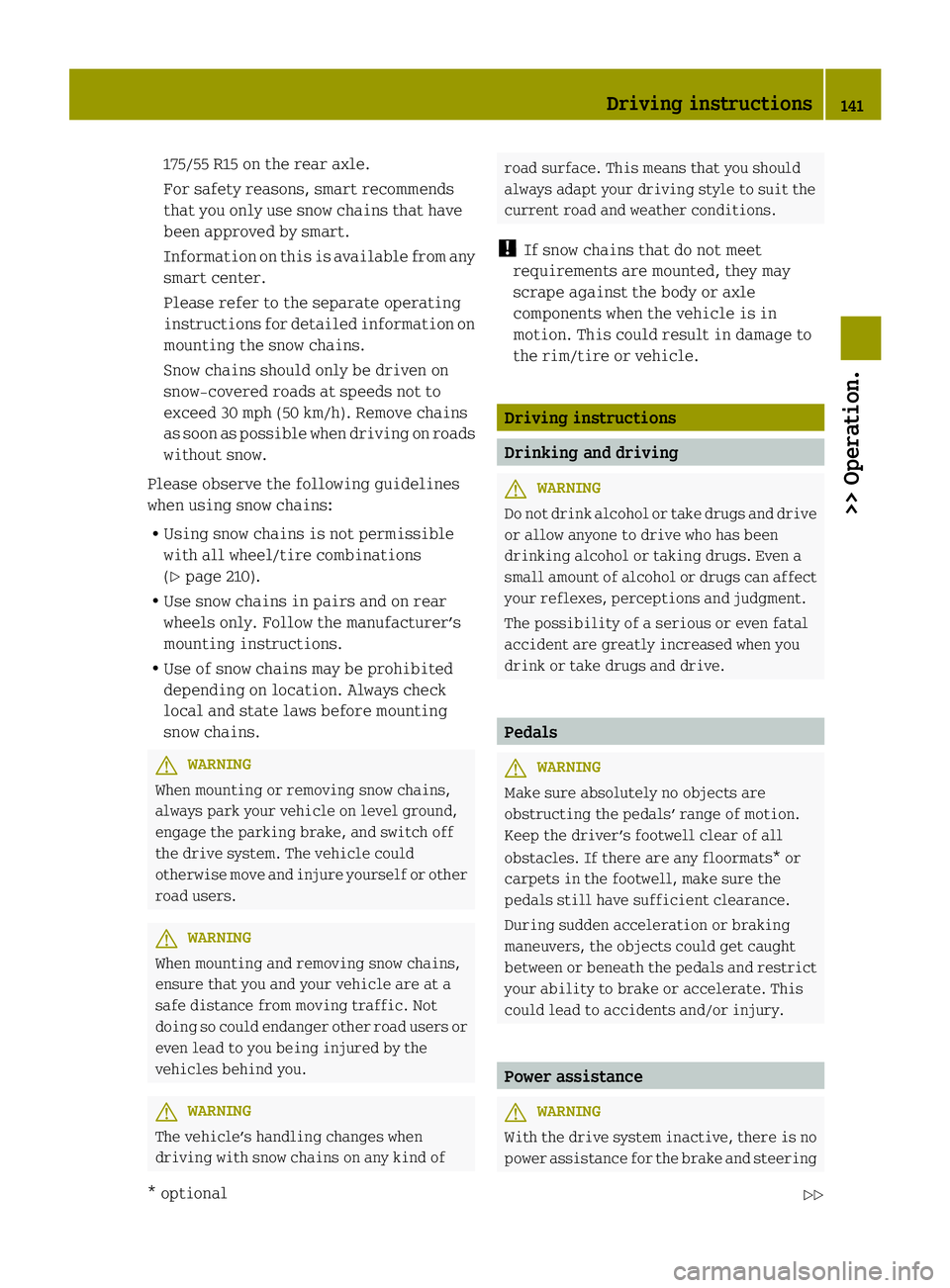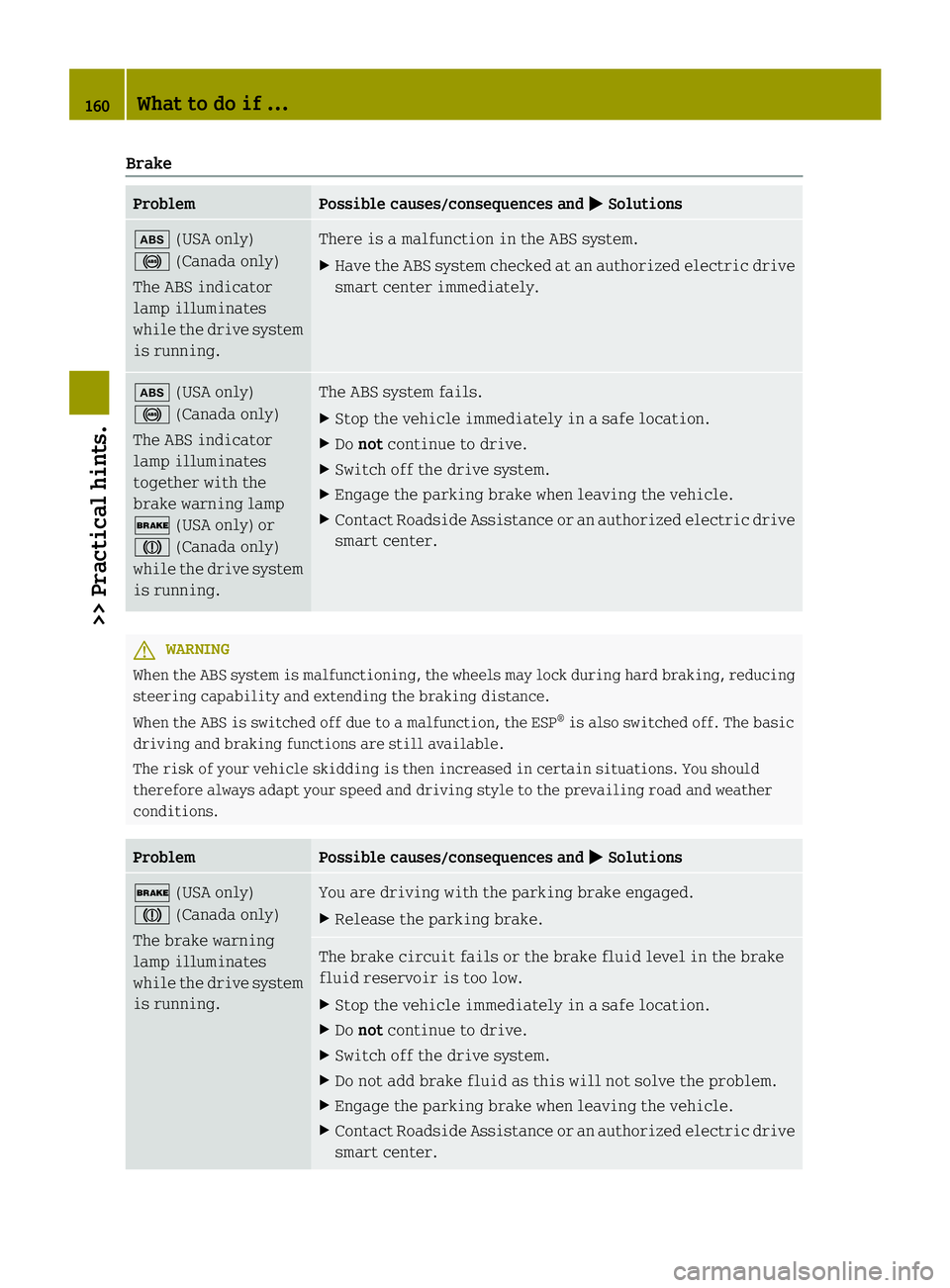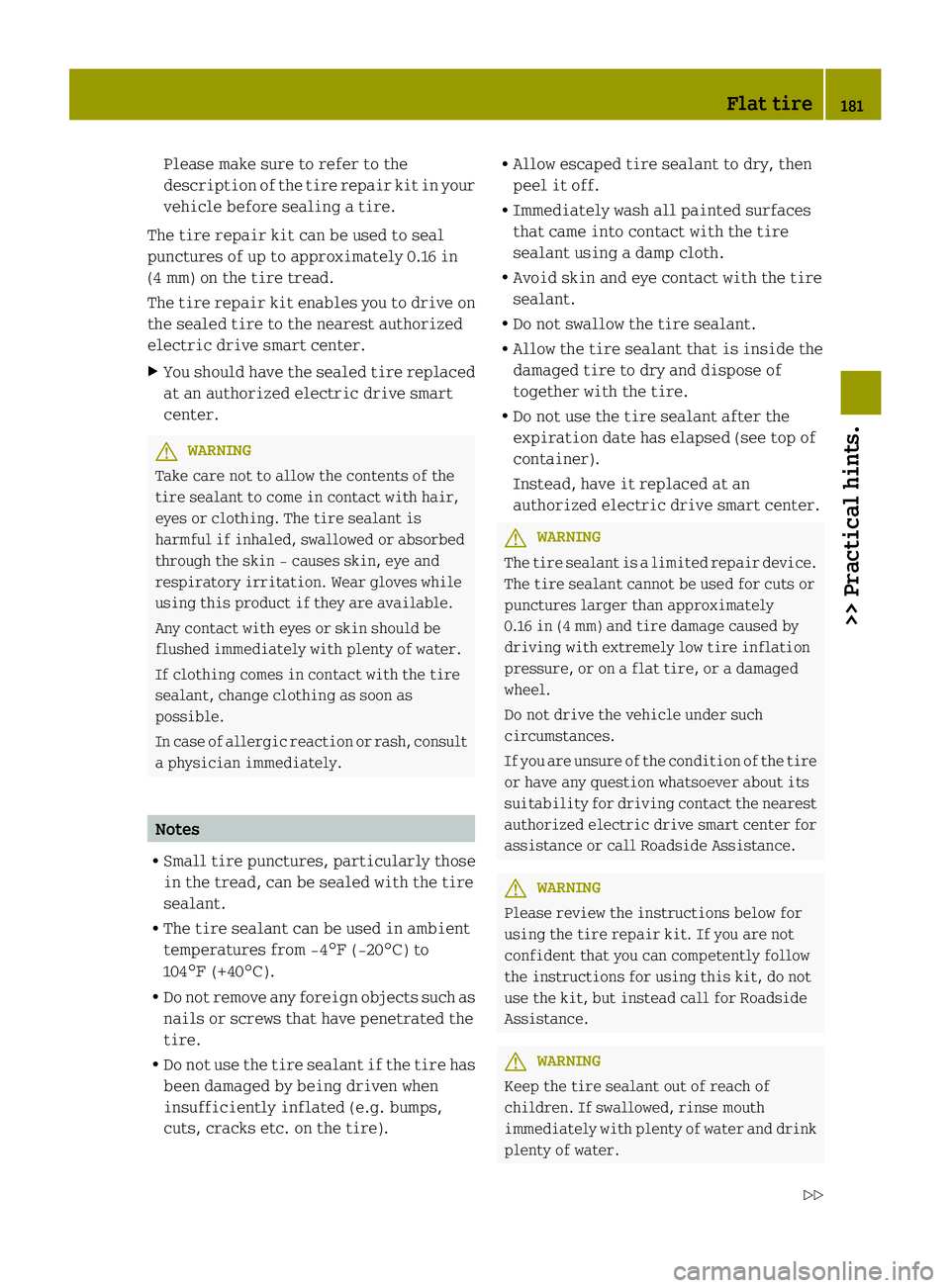2013 SMART FORTWO COUPE ELECTRIC DRIVE ABS
[x] Cancel search: ABSPage 143 of 218

175/55 R15 on the rear axle.
For safety reasons, smart recommends
that you only use snow chains that have
been approved by smart.
Information on this is available from any
smart center.
Please refer to the separate operating
instructions for detailed information on
mounting the snow chains.
Snow chains should only be driven on
snow-covered roads at speeds not to
exceed 30 mph (50 km/h). Remove chains
as soon as possible when drivin gonroads
without snow.
Please observe the following guidelines
when using snow chains:
R Using snow chains is not permissible
with all wheel/tire combinations
(Y page 210).
R Use snow chains in pairs and on rear
wheels only. Follow the manufacturer’s
mounting instructions.
R Use of snow chains may be prohibited
depending on location. Always check
local and state laws before mounting
snow chains. G
WARNING
When mounting or removing snow chains,
always park your vehicle on level ground,
engage the parking brake, and switch off
the drive system. The vehicle could
otherwise move and injure yourself or other
road users. G
WARNING
When mounting and removing snow chains,
ensure that you and your vehicle are at a
safe distance from moving traffic. Not
doing so could endanger other road users or
even lead to you being injured by the
vehicles behind you. G
WARNING
The vehicle’s handling changes when
driving with snow chains on any kind of road surface. This means that you should
always adapt your driving style to suit the
current road and weather conditions.
! If snow chains that do not meet
requirements are mounted, they may
scrape against the body or axle
components when the vehicle is in
motion. This could result in damage to
the rim/tire or vehicle. Driving instructions
Drinking and driving
G
WARNING
Do not drink alcohol or take drugs and drive
or allow anyone to drive who has been
drinking alcohol or taking drugs. Even a
small amount of alcohol or drugs can affect
your reflexes, perceptions and judgment.
The possibility of a serious or even fatal
accident are greatly increased when you
drink or take drugs and drive. Pedals
G
WARNING
Make sure absolutely no objects are
obstructing the pedals’ range of motion.
Keep the driver’s footwell clear of all
obstacles. If there are any floormats* or
carpets in the footwell, make sure the
pedals still have sufficient clearance.
During sudden acceleration or braking
maneuvers, the objects could get caught
between or beneath the pedals and restrict
your ability to brake or accelerate. This
could lead to accidents and/or injury. Power assistance
G
WARNING
With the drive system inactive, there is no
power assistance for the brake and steering Driving instructions
141>> Operation.
* optional Z
Page 162 of 218

Brake
Problem Possible causes/consequences and
0001 Solutions
0005
(USA only)
0008 (Canada only)
The ABS indicator
lamp illuminates
while the drive system
is running. There is a malfunction in the ABS system.
X
Have the ABS system checked at an authorized electric drive
smart center immediately. 0005
(USA only)
0008 (Canada only)
The ABS indicator
lamp illuminates
together with the
brake warning lamp
0002 (USA only) or
0001 (Canada only)
while the drive system
is running. The ABS system fails.
X
Stop the vehicle immediately in a safe location.
X Do not continue to drive.
X Switch off the drive system.
X Engage the parking brake when leaving the vehicle.
X Contact Roadsid eAssistance or an authorize delectric drive
smart center. G
WARNING
When the ABS system is malfunctioning, the wheels may lock during hard braking, reducing
steering capability and extending the braking distance.
When the ABS is switched off due to a malfunction, the ESP ®
is also switched off. The basic
driving and braking functions are still available.
The risk of your vehicle skidding is then increased in certain situations. You should
therefore always adapt your speed and driving style to the prevailing road and weather
conditions. Problem Possible causes/consequences and
0001 Solutions
0002
(USA only)
0001 (Canada only)
The brake warning
lamp illuminates
while the drive system
is running. You are driving with the parking brake engaged.
X
Release the parking brake. The brake circuit fails or the brake fluid level in the brake
fluid reservoir is too low.
X
Stop the vehicle immediately in a safe location.
X Do not continue to drive.
X Switch off the drive system.
X Do not add brake fluid as this will not solve the problem.
X Engage the parking brake when leaving the vehicle.
X Contact Roadside Assistance or an authorized electric drive
smart center. 160
What to do if ...>> Practical hints.
Page 183 of 218

Please make sure to refer to the
description of the tire repair kit in your
vehicle before sealing a tire.
The tire repair kit can be used to seal
punctures of up to approximately 0.16 in
(4 mm) on the tire tread.
The tire repair kit enables you to drive on
the sealed tire to the nearest authorized
electric drive smart center.
X You should have the sealed tire replaced
at an authorized electric drive smart
center. G
WARNING
Take care not to allow the contents of the
tire sealant to come in contact with hair,
eyes or clothing. The tire sealant is
harmful if inhaled, swallowed or absorbed
through the skin - causes skin, eye and
respiratory irritation. Wear gloves while
using this product if they are available.
Any contact with eyes or skin should be
flushed immediately with plenty of water.
If clothing comes in contact with the tire
sealant, change clothing as soon as
possible.
In case of allergic reaction or rash, consult
a physician immediately. Notes
R Small tire punctures, particularly those
in the tread, can be sealed with the tire
sealant.
R The tire sealant can be used in ambient
temperatures from ‑4 ¦(‑20¥ ) to
104¦ (+40¥ ).
R Do not remove any foreig nobjects such as
nails or screws that have penetrated the
tire.
R Do not use the tire sealant if the tire has
been damaged by being driven when
insufficiently inflated (e.g. bumps,
cuts, cracks etc. on the tire). R
Allow escaped tire sealant to dry, then
peel it off.
R Immediately wash all painted surfaces
that came into contact with the tire
sealant using a damp cloth.
R Avoid skin and eye contact with the tire
sealant.
R Do not swallow the tire sealant.
R Allow the tire sealant that is inside the
damaged tire to dry and dispose of
together with the tire.
R Do not use the tire sealant after the
expiration date has elapsed (see top of
container).
Instead, have it replaced at an
authorized electric drive smart center. G
WARNING
The tire sealant is alimited repair device.
The tire sealant cannot be used for cuts or
punctures larger than approximately
0.16 in (4 mm) and tire damage caused by
driving with extremely low tire inflation
pressure, or on a flat tire, or a damaged
wheel.
Do not drive the vehicle under such
circumstances.
If you are unsure of the condition of the tire
or have any question whatsoever about its
suitability for driving contact the nearest
authorized electric drive smart center for
assistance or call Roadside Assistance. G
WARNING
Please review the instructions below for
using the tire repair kit. If you are not
confident that you can competently follow
the instructions for using this kit, do not
use the kit, but instead call for Roadside
Assistance. G
WARNING
Keep the tire sealant out of reach of
children. If swallowed, rinse mouth
immediately with plenty of water and drink
plenty of water. Flat tire
181>> Practical hints.
Z
Page 212 of 218

Rims and tires
Notes
! Only use tires which have been tested
and approved by smart. Tires approved by
smart are developed to provide best
possible performance in conjunction
with the driving safety systems on your
vehicle such as the ABS or the ESP ®
.
Using tires other than those approved by
smart may result in damage that is not
covered by the smart Limited Warranty.
! Using tires other than those approved
by smart can have detrimental effects,
such as
R poor handling characteristics
R increased noise
R increased energy consumption
Moreover, tires and rims not approved by
smart may, under load, exhibit
dimensional variations and different
tire deformation characteristics that
could cause them to come into contact
with the vehicle body or axle parts.
Damage to the tires or the vehicle may be
the result.
i Further information on tires and rims
is available at any authorized electric
drive smart center. A placard with the
recommended tire inflation pressure is
located on the driver’s door B‑pillar.
The tire inflation pressure should be
checked regularly and should only be
adjusted on cold tires. Follow tire
manufacturer’s maintenance
recommendation included with vehicle. Mobility
Your vehicle is equipped with a tire repair
kit (Y page 180). In case of a flat tire, it
enables you to drive to the nearest
authorized electric drive smart center on
the sealed tire. If the tire is damaged too severely for the
tire sealant to provide a reliable tire
repair:
X
Contact the nearest authorized electric
drive smart center.
or
X Call Roadside Assistance. 210
Rims and tires>> Technical data.
Page 214 of 218

Capacities
Components Capacity Coolants, lubricants, etc.
Coolant system approx. 7.8 US qt (7.4 l) Anticorrosion/Antifreeze
meeting specification MB 325.0
Air conditioning system — R134a refrigerant and special
PAG lubricant oil (never R 12)
Windshield washer
system 1.1 US qt (1.0 l)
Windshield washer concentrate
13
(Y page 212)
Washer fluid mixing ratio
(Y page 212) Brake fluid
G
WARNING
During vehicle operation, the boiling
point of the brake fluid is continuously
reduced through the absorption of moisture
from the atmosphere. Under extremely
strenuous operating conditions, this
moisture content can lead to the formation
of bubbles in the system, thus reducing the
system’s efficiency.
Therefore, the brake fluid must be replaced
regularly. Refer to your vehicle’s
Maintenance Booklet for replacement
interval.
Only brake fluid approved by smart is
recommended. Any authorized electric
drive smart center will provide you with
additional information. Windshield/rear window washer system
During all seasons:
X Use a windshield washer concentrate
labeled for summer and water for
temperatures above freezing point.
X Use a windshield washer concentrate
labeled for winter and water for
temperatures below freezing point.
X Premix the windshield washer fluid in a
suitable container depending on the
outside temperature and in accordance
with the manufacturer’s instructions 14
.
Washer fluid mixing ratio R
Temperature above 32¦ (0¥):
1 part windshield washer concentrate
labeled for summer to 100 parts water
R Temperature of 14¦ (-10¥):
1 part windshield washer concentrate
labeled for winter to 2 parts water
R Temperature of -4¦ (-20¥):
1 part windshield washer concentrate
labeled for winter to 1 part water
13 Use a windshield washer concentrate labeled for summer and water for temperatures above freezing
point or a windshield washer concentrate labeled for winter and water for temperatures below freezing
point.
14 Refer to the notes for use on the container. 212
Service fluids and capacities>> Technical data.